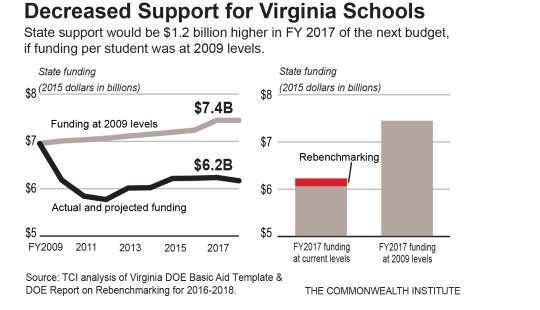October 6, 2015
Finding the Right Benchmark of Support for Our Schools
Virginia prides itself on having high-quality schools that prepare students for a successful and productive future. To continue to meet those expectations, the governor and state legislators need to heed recent warnings and restore the state’s historic support for schools when they begin revising the formula the state uses to determine how much funding schools need.
Financial support for schools comes from both state and local governments. But the state is in control of the formula that sets the benchmark of support schools need in order to meet minimum standards of quality. To keep that benchmark current, the state updates it every two years with new information that reflects changes in enrollment, student needs, inflation, and other factors.
The initial estimate from the Virginia Department of Education calculates that it will cost the state about $390 million over the next two years to continue providing the same quality of education. That’s about a 3 percent increase.
But this modest update to the state’s support for K-12 schools should not be confused with an actual increase in support. Schools will continue to receive the same amount of support from the state relative to the cost of providing kids with a quality education, which has increased over the last two years. The process simply swaps out old, out-of-date numbers with new, current ones that reflect inflation and other factors that have increased costs, but it doesn’t involve changes to policy or support for new programs. In other words, nothing changes.
However, the state has made changes to the benchmark standards in recent years that have resulted in sizable cuts to the state’s support for local schools. They did this by changing simple assumptions in the math, such as how long a bus can operate before it needs to be replaced, limiting support for certain staffing positions like psychologists and social workers, and excluding some supplies that schools need to operate. These changes have lowered the benchmark of support from the state.
The reality is any increased investment in our schools needs to go above and beyond the $390 million schools need to just keep treading water. And if the state wants to restore the cuts made during the recession, then it needs to go well beyond that number. Virginia would need to spend an additional $1.21 billion in 2017 and $1.28 billion in 2018 to provide the same amount of funding per student as fiscal year 2009, using the state’s enrollment projections and using a modest 1.5 percent inflation. That’s a total of $2.49 billion over the next two years.

As Governor McAuliffe looks to keep his commitment to invest in Virginia’s K-12 schools, he should do more than simply update the numbers. He should raise our standards back up to the levels that helped make Virginia’s schools so successful in the past, so that our kids can have the best opportunity for a successful future.
–Chris Duncombe, Policy Analyst
